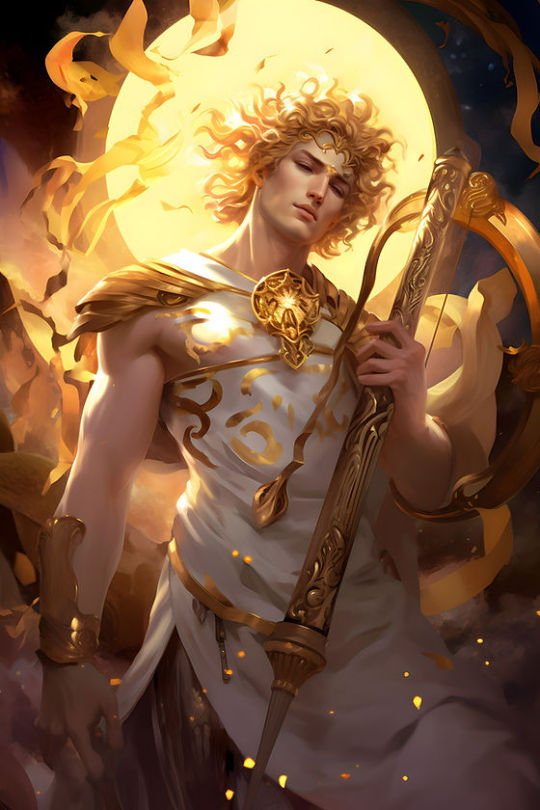A blog dedicated to educating others about polytheism, paganism, witchcraft, Greek mythology, and more!
Don't wanna be here? Send us removal request.
Text
Apollo & the Muses
The god of sun, light, music, poetry, and art: Artemis’s twin Apollo! I’m sure that most people are aware that these are the things he is most well known for, especially when it comes to the sun and light, but did you know he was also a god of deadly plagues, prophecy, and archery? After his mother was cursed by Hera due to Zeus having yet another affair, Leto was forced to birth him on the island of Delos since it didn’t connect to any main lands. He is a god with an athletic and youthful build, meaning he doesn’t sport any facial hair (or has very little). He has another name, referred to as his forename, and that name is Phoebus after his grandmother, Phoebe, who was a titan. Though his name is the same in both Greek and Roman mythology, the things he rules over have different focuses; for example, in Roman mythology, it’s emphasized that he is the god of healing and prophecy whereas in Greek mythology he’s the god of sun and light. As mentioned in the beginning of this post, Apollo could bring deadly plagues just as much as he could heal people; in fact, there’s a story where he plagued Greek bases during the Trojan war, a war in which he also killed Achilles. Apollo was a highly praised god who brought great amounts of joy to Olympus through music and magic which he engaged in with his friends, the muses. The muses were nine goddesses known for their inspirational art and music that also judged certain competitions involving Apollo. There was one such competition where a mortal claimed to be more musically inclined than Apollo, so he was challenged and lost when the muses declared Apollo more gifted. This resulted in the mortal, a satyr named Marsyas, in being skinned alive as punishment; his skin was then nailed to a pine tree. Another fact about Apollo is that Hermes is his half brother, and the music Apollo plays, is played on a lyre made for him by Hermes. The lyre is one of Apollo’s many symbols; his others include animals such as dolphins and swan, plants such as the laurel tree (which became a status symbol), bow and arrow, and the sun! He also had many offspring, the most well known being Asclepius and Orpheus, and a romantic relationship with a nymph named Daphne. After being hit with an arrow from zeros (Cupid), Apollo fell in love with a Nymph named Daphne, who I’ll elaborate on in another post. His son Orpheus inherited Apollo’s music skills, while Asclepius had his skills of healing and medicine which were taught to man. Something else Apollo is known for is killing the cyclops who made Zeus’s thunderbolts in retaliation to Zeus killing his son, Asclepius. Dating back to 5th century BC, it is said that Apollo is closely linked with Nyx’s son, Helios, but that’s as far back as that relation goes. He was a major inspiration to many Greeks and Romans; so much so, a mortal ruler named Octavian claimed Apollo as a patron and had a temple constructed for and dedicated to him. Speaking of temples, Naxos is a sacred site of Apollo’s, where the massive doorway of a once great temple may still stand!
-
Sources:
Greekgodsandgoddesses.net
Worldhistory.org/apollo
thecollector.com

1 note
·
View note
Text
Medusa: Greek Vs Roman Myths
So, I’m sure we are all familiar with the story of how Medusa was originally a beautiful maiden who was cursed by Athena for being sexually assaulted in Athena’s temple, but did you know that’s the Roman myth? This myth was written by Ovid, a Roman poet. He may have started out his story with her being this beautiful maiden that was cursed, but in the end, he painted her as a monster who’s head was to be used as a weapon. In Ovid’s poem, her story is tragic and forced readers to develop feelings of sympathy and empathy, whereas in the Greek mythology she was always born a gorgon; in fact, she was one of the three gorgon sisters, the other two being Stheno and Euryale. These three sisters were born from Phorcys and Ceto, and they made the farthest point of the world their home: the edge. A similarity between both the Greek and Roman version is that, Medusa is a mortal who’s story ended in being beheaded. No matter which story you believe, both end with Perseus beheading and using her as a weapon. Depending on your point of view, both stories ended in a tragedy, but no matter which one sticks with you, both show her as a symbol of power. If she wasn’t powerful, they wouldn’t have killed her and used her to combat and stone their enemies, she would’ve been no use to any of them without the power she withheld. Medusa is fierceness, she is power, she is strength, she is anything but a monster in my eyes.
-
Important Note: it was said that Ovid’s poem was written based on complete bias.
-
SOURCES:
(https://windswaves.wordpress.com/2019/08/26/hidden-from-view-the-medusa-myth-from-ovids-metamorphoses-to-peter-paul-rubens/)
(https://www.laphamsquarterly.org/fear/dread-gorgon#:~:text=In%20mythology%2C%20the%20Gorgons%20were,)%20and%20Gaia%20(Earth).)
(https://mythopedia.com/topics/gorgons)

(Credit to InkImagine on Deviant Art)
#greek mythology#greek tumblr#greek gods#medusa#gorgon#roman mythology#ancient greek#myth#ovid's metamorphoses#blog#blog post
0 notes